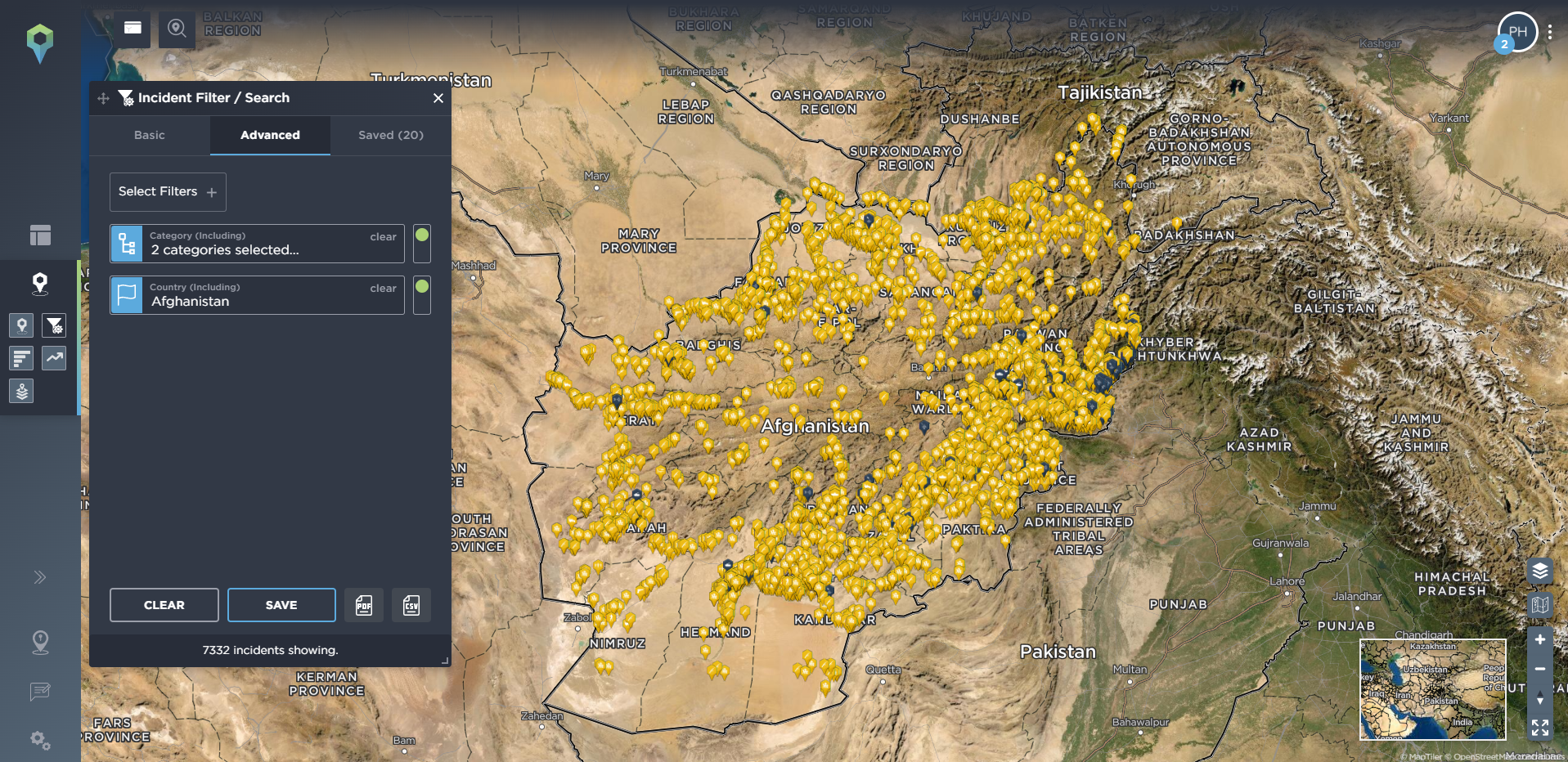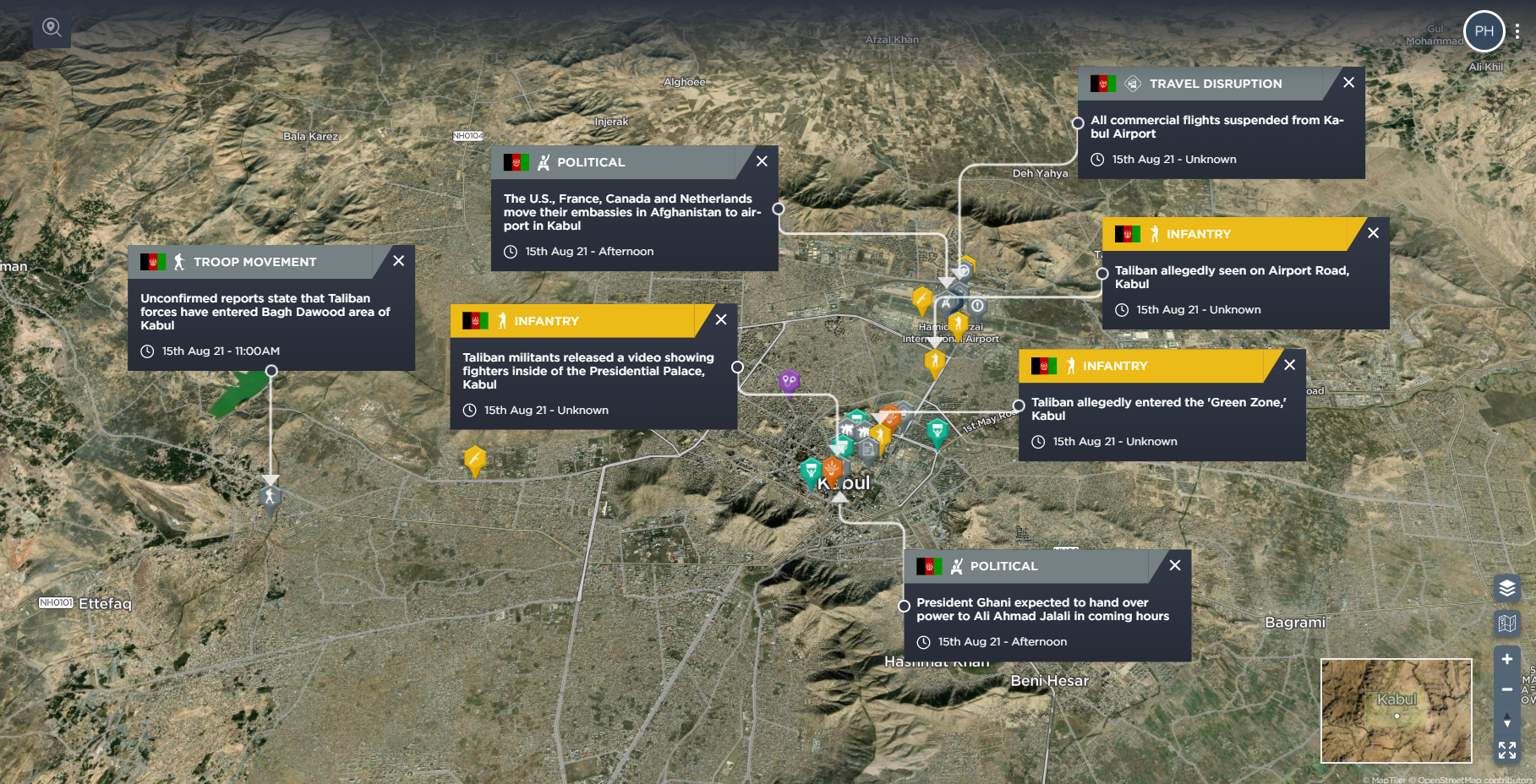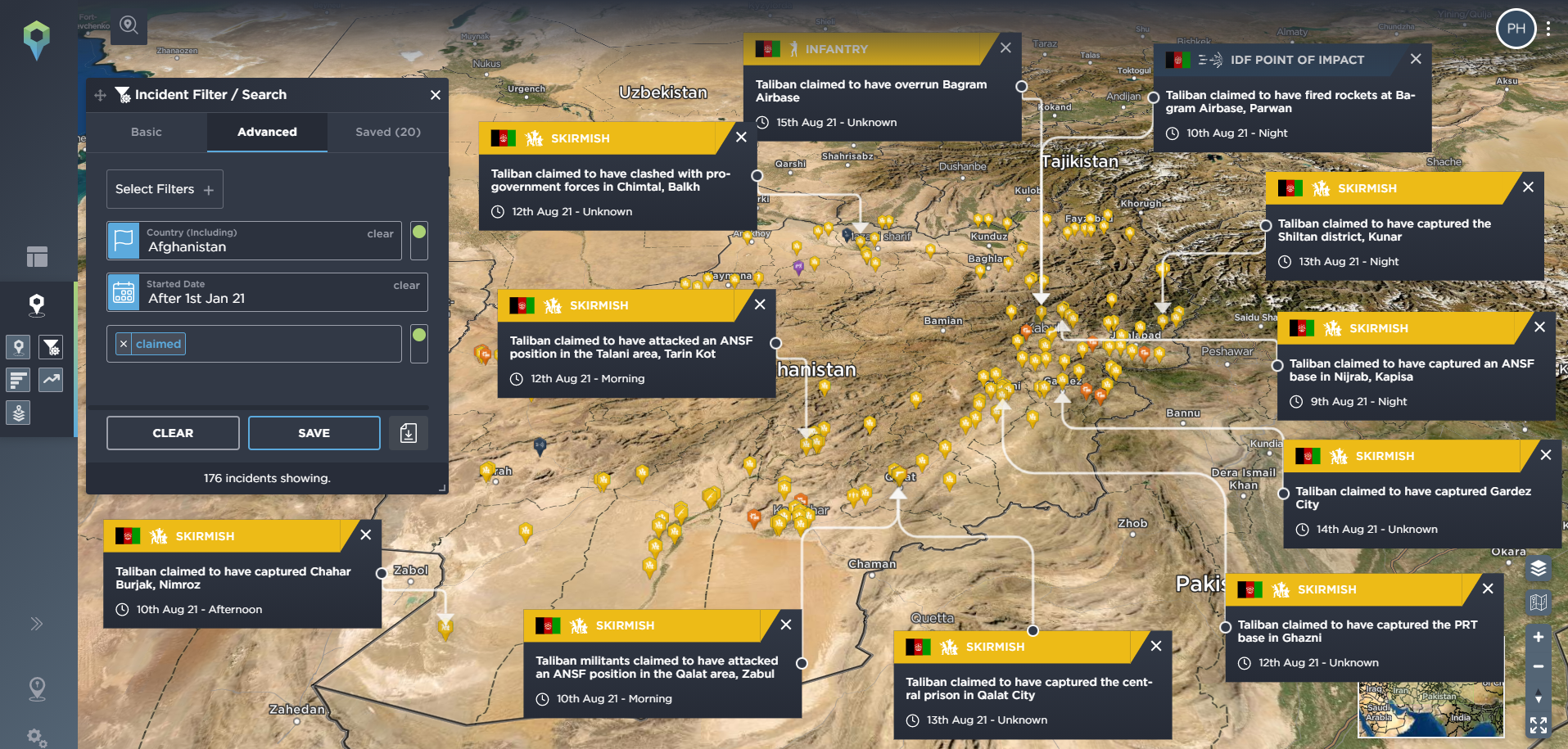What is Iran’s plan for Afghanistan under Taliban rule?
Iran’s response to the Taliban takeover of Afghanistan is likely to be shaped by a number of potentially conflicting factors however, understanding what Iran's plan for Afghanistan will be following this new reality requires some exploration of the context of the country itself.
What are Iran’s national security concerns?
Iran is protected, hindered and contained geopolitically by mountain ranges which completely border the country. Although hindered by geography, the country’s major leverage comes in the form of the Strait of Hormuz. This strategic oil transit choke point acts as Iran’s weapon of mass global economic destruction if it wishes to retaliate. This strategic weapon will likely be supplemented in the next few months by Iran achieving a nuclear bomb, if Israeli Alternate Prime Minister and Minister of Defense Benny Gantz is correct.
In recent history the main regional threat to Iran’s influence came with the US invasion into Afghanistan in 2001. In 2002, President George Bush gave his “Axis of Evil” speech and highlighted Iran, along with Iraq, North Korea, Cuba, Libya and Syria as being state sponsors of terrorism and countries that sought weapons of mass destruction. With the 2003 invasion into Iraq, Iran found itself with US military bases to its East, South and West. Iran was clearly in the cross hairs of the US and it was therefore in Iran’s strategic interests to push back against US forces by supporting proxy groups in neighbouring countries. In response, Iran formed a political alliance that it called the “Axis of Resistance” comprising Iran, Syria and Hezbollah. Iran also used the Shia Crescent, which are regions of the Middle East where the majority population is Shia, or where there is a strong Shia minority to apply this pressure.
Demographics are also key in understanding Iran and its national security issues, as well as regional priorities. In 2021, the population of Iran reached about 85 million people. According to the CIA World Factbook, 61% of Iranians are of Persian ethnicity. Azeris count for 16%, Kurds 10%, Lurs 6%, Arabs 2% and Balochs 2%.
When you look at a map of the ethnic groups, Arabs are located in the South West in Khuzestan. This area was invaded by Iraq in 1980 during the Iran-Iraq War. The provice witnessed an uprising in 1979, unrest in 2005, bombings in 2005–06 and protests in 2011.
In the North West, there are populations of ethnic Kurds and Azeris. The Azerbaijani people were divided by the Russian and Persian empires in the 19th Century. Since the declaration of independence of the Azerbaijan Republic in 1991, Iran likely now fears the potential growth of a secessionist movement from its own Azeri population and saw mass protests in 2006 following the publication of a cartoon that compared Iranian Azerbaijanis to cockroaches. However, the Republic of Azerbaijan is between 75%+ Shia Muslim, therefore it is in their best interest to remain allies with the foremost Shia power in the world, which will likely prevent any Azeri secessionist movement really taking hold in Iran.
The Kurds are the largest ethnic group in the world without a country and span across Iran, Iraq, Syria and Turkey. Most Kurds are Sunni Muslims, however Alevism and Shia Islam also have millions of Kurdish followers. Deniz Ekici, Professor of Kurdish Studies at UC Berkeley has stated, “Iran and Turkey are very much against the establishment of a Kurdish state even outside of their borders because they fear that if there is a Kurdish political entity anywhere in the Middle East, this would threaten the so called national unity of these two countries”. In opposition to this, Israel has been vocal in their support for a Kurdish state, which Israel sees as a potential ally in a region where there is widespread hostility to Israel.
Balochis are Sunni Muslims and are mainly located in the South East of the country, in the areas of Iran that border Pakistan and Afghanistan. The Balochi parts of Iran are considered to be the most underdeveloped and poorest regions of the country, which makes them fertile ground for rebel and secessionist groups. The Sistan and Baluchestan insurgency, part of the Balochistan conflict, began in 2004 and is an ongoing low-intensity asymmetric conflict in Sistan and Baluchestan Province between Iran and several Baloch Sunni militant organizations which are designated as terrorist organizations by Iran.
These national security threats are further exacerbated by crippling sanctions, which have meant that Iran’s economy has been shrinking since 2017, the country fell into a trade deficit of 3.45 billion USD in 2020, inflation dramatically increased in 2018 and 2019 and an estimated 12.4% of the population is expected to be out of work in 2021.
Further, Iran hosts one of the largest refugee populations in the world, the vast majority of whom are from Afghanistan. Around 780,000 registered Afghan refugees and between 2.1 to 2.5 million undocumented Afghans live in Iran. With Iran’s internal issues, any increase in the quantity of refugees would only exacerbate Iran’s problems. Iran also fears Islamic State gaining a foothold in Afghanistan that could be used as an operational springboard to target Iran.
What is Iran’s attitude towards the Taliban?
When looking at the Taliban and Iran’s view of them, it’s important to remember that the Taliban emerged in the 1990s in northern Pakistan following the withdrawal of Soviet troops from Afghanistan. It is believed that the predominantly Pashtun movement first appeared in religious seminaries – mostly paid for by money from Saudi Arabia – which preached a hardline form of Sunni Islam. Iran therefore has had a difficult relationship with the Taliban, due to their religious affiliation and links to Saudi Arabia. In the late 1990s, Iran considered the Taliban a national security threat, backed anti-Taliban Afghan resistance forces, and almost invaded Afghanistan to punish the Taliban for killing its diplomats.
In the first decade after the 2001 invasion, both Iran and the Taliban denied their cooperation, however there appears to have been at least some support of the Taliban from Tehran in response to the US and NATO presence in Afghanistan. Iran conducted operations to impede the coalition forces’ mission in an attempt to remove US and NATO forces from the country – this was a multi-pronged approach in numerous theatres, as Iran attempted to remove US forces from the region entirely, or at least significantly reduce their presence and power projection ability.
Taliban and Iranian cooperation can be summed up in an article by the Middle East Institute, where it is stated that, ‘A survey of the Afghan and Iranian press and statements by government officials of the two countries suggest that Iran’s strategy of supporting the Taliban had four key dimensions:
- to undercut the US mission and accelerate American troop withdrawal from Afghanistan;
- to establish a buffer zone in western Afghanistan against the threat of the so-called Islamic State along its eastern border;
- to use its ties with the Taliban for its geopolitical agenda in South and Central Asia as well as in the Middle East;
- and to pressure the Afghan government for political concessions’.
More recently there have been numerous meetings in 2021 between Iran and the Taliban. In January, Mullah Abdul Ghani Baradar, the Taliban diplomatic chief met with Ali Shamkhani, the head of Iran’s Supreme National Security Council and Iranian foreign minister Mohammad Javad Zarif in Tehran. Iran reportedly stated that they would not support any Afghan faction that takes power by force. Zarif stated that Iran would support a broad “Islamic government” in Kabul encompassing all ethnicities and religious branches. Baradar offered to help Iran secure its border with Afghanistan.
In July, Iran’s Foreign Ministry hosted delegations from the Afghan government and Taliban, as they attempted to fill the diplomatic gap left by departing US forces, as well as highlight security concerns. At the same time Iran also reportedly bolstered its military forces on the border with Afghanistan.
What is Iran's plan for the Afghan Shiites?
Afghanistan has a population of 38 million people, 90% of which follow Sunni Islam. The other 10% is made up mainly of Shia Muslims. With the Sunni Taliban retaking control of the country, Iranian leaders will be worried whether the large Shia minority will be protected.
Looking at a map showing the religious composition of Afghanistan, you can see that the majority of Imami Shia Muslims (dark green) are located in the centre of the country, with smaller pockets in the North, South West and West of the country. Ishmaili Shia Muslims (brown) are located to the West and North East of Kabul. Iran will monitor the situation carefully, and if the Shia population is treated fairly, there could be continued rapprochement between the Taliban and Iran. In this scenario Iran will likely continue to use soft power to maintain influence over the Afghan Shia community, with areas like Herat and Zaranj being easier to influence due to their close proximity to Iran. However, if Sunni elements openly attack Shia religious communities, then this could trigger a response from Iran.
Iran has been using Afghan fighters in Syria, recruited from the Hazara community. Liwa Fatemiyoun, also known as Fatemiyoun Brigade or Hezbollah Afghanistan, are believed to be funded, trained and equipped by Iran’s IRGC and fights under the command of Iranian officers. The group is believed to number between 10,000 – 20,000 fighters and have been used in Syria since 2012. If Iran wanted to exert force in Afghanistan, these fighters would be the most likely initial force to be used to either raise new units of Shia fighters in the country, or carry out attacks themselves. A worrying report which may foreshadow future developments comes from Amnesty International, who claim that between 4th – 6th July 2021, the Taliban tortured and massacred Hazara men when they took control of Ghazni Province. If the Hazaras face similar intense persecution as was witnessed during the Taliban’s previous rule by ethnic Pashtuns and hardline Sunnis who do not consider Shia to be true Muslims, sectarian conflict will likely occur. In this scenario Iran, wanting to show themselves as being the guarantor of Shia Islam in the region, will throw significant financial and military support behind the Shia minority.
Is there potential for Iranian conflict with the Taliban?
Future conflict will likely depend on the treatment of the Afghan Shia community and the presence of Islamic State of Iraq and the Levant – Khorasan Province (IS-KP). Historically, Iran prepared plans with the Northern Alliance to launch a retaliatory military incursion into Afghanistan in 1998, when the Taliban massacred eight Quds Force operatives and a reporter at the Iranian consulate in Mazar-e Sharif. Although the operation was called off, the plan reportedly was to capture Herat and draw Taliban resources there, enabling the Alliance to take Kabul and then link up with the Iranians in Herat.
Another issue which may lead Iran and the Taliban on a path towards conflict is that of water security. At the time of the above potential military incursion, Iran was also going through one of the worst droughts it had witnessed in decades. This drought, which began in 1998 and ended in 2001 was exacerbated by the Taliban’s closure of the Kajaki Dam, denying vital water to Iranian farmland across the border.
In recent years, officials in Farah Province accused Iran of supporting the Taliban in order to obstruct construction of dams in southern and western provinces. Jamila Amini, the head of Farah’s provincial council stated, “As the agreement for the construction of Bakhtabad dam [in Farah] was finalized, their [Iran’s] support [to the Taliban] increased and the Taliban are threatening Farah’s security with more sophisticated weapons so that work on the Bakhshabad’s dam does not begin”.
Iran’s water security issues have not gone away just because the Taliban are back in power and they will need to have good relations to ensure that the Taliban do not impact Iran’s water security, however, with climate change and both country’s proximities likely making them at extreme risk to water related risks, eventually this issue will likely flare up, causing a requirement for Iran to use force to ensure its water security.
Any periods of drought will likely cause a flare up and increased tensions between the countries. If the Taliban try to improve the agricultural sector, or access to electricity, there may be requirements to increase water usage or build/expand hydro electric dams. Again, this will also likely lead to increased tensions. With Iran’s eastern provinces being particularly vulnerable to water scarcity, movements like the Sistan and Baluchestan insurgency may receive increased support over local dissatisfaction over water security, however, based on the national security issues highlighted, this could have much wider implications for Iran.
Will Saudi renew their support for the Taliban?
The previous Taliban regime was supported by Saudi Arabia – however, that had to change after 9/11, especially when considering the profile of the terrorists who conducted the attack. Saudi Arabia has a requirement to have good relations with the United States, therefore the kingdom had to revaluate its support for the Taliban, which created an opportunity for Iran and the Taliban to become closer.
With the US withdrawal from Afghanistan, this may create an opportunity for Saudi Arabia to realign its interests with the Taliban and project power against Iran from its East, likely through the support of anti-Iranian militant groups. Iran will attempt to retain good relations with the Taliban in an attempt to mitigate this potential reestablishment of good relations with the Saudis. For Iran, their key strategic goal will be to prevent their US enemy being replaced by Saudi backed enemies on their doorstep.
What would an Iranian invasion of Afghanistan look like?
Any military invasion of Iran would likely initially focus on the Shia areas of Herat and Zaranj. These two cities are in close proximity to Iran’s border and would be relatively easy for Iran to take, and hold, especially with local support. The next key task for Iran militarily would be to link up these cities with the Hazara heartland which sits in the centre of the country and means the Iranian military would have to fight through Pashtun country in order to achieve this objective.
Even if successful, which has been proven by NATO and the Soviets as being extremely difficult in the long term, the Iranians would have supply lines hundreds of kilometres long that would be easily targeted by militants. The difference between an Iranian invasion and a NATO/Soviet invasion would be Shia ‘liberating’ Shia, certainly in Herat and Zaranj. Would this draw comparisons with Donetsk and Lugansk (Donbas) with a large ethnic Russian population who identify more with Russia than Ukraine and have allowed Moscow to effectively claim the region? It seems likely that Iran would set smaller objectives, similar to what Turkey has done in Syria. They would create a buffer zone in Afghanistan and then support ethnic Hazaras as rebel forces against the Taliban and Sunni militant groups, with an ideal objective of linking the buffer zone with Hazara heartland areas. Iran’s excuse could be to create a safety zone to allow Afghan refugees living in Iran to return to Afghanistan safely.
As the situation develops in Afghanistan and the wider geopolitical impacts of the Taliban rule begin to become apparent across the world, organisation will need a reliable threat intelligence solution to stay informed.
Whether you require timely incident-based alerts, powerful visualisation software, regular intelligence reports, or even your own dedicated analyst, Intelligence Fusion is the preferred provider of threat intelligence solutions for militaries, law enforcement agencies and Fortune 500 companies.
To take a closer look at the data, principles and team behind this analysis, speak to a member of the team today.



